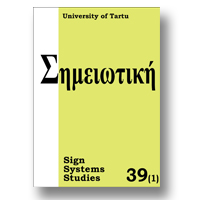|
22.
|
Sign Systems Studies:
Volume >
33 >
Issue: 1
Linnar Priimägi
The problem of the autocatalytic origin of culture in Juri Lotman’s cultural philosophy
abstract |
view |
rights & permissions
| cited by
The origin of culture remains in the sphere of hypotheses. Although the hypotheses derive from two presumptions: first, how the structure of culture is envisaged, and secondly, how culture is thought to function. Juri Lotman dealt with both aspects of culture, initially the structural and typological and later the dynamic aspects. Thereby, he arrived at the culturalphilosophical hypothesis of the autocatalytic origin of culture. A catalyst is a component of a chemical reaction which itself doesn’t transform during the reaction, but whose presence is needed to guarantee the reaction (or to stimulate it). Thus, autocatalysis is a paradoxical situation in which the genesis of something presumes the pre-existence of the final product. The paradox of the autocatalysis of culture lies in the fact that culture cannot emerge from anything other than from culture itself, from its own germination. In 1988, speaking about the autocatalysis of culture, Lotman refered tothe cultural historicist Nikolai I. Konrad (1891–1970), who undoubtedly borrowed this idea from Jacob Christopher Burckhardt (1818–1897). This undiscovered connection reminds us of the fact, that a model for autocatalysis (or an autopoiesis) was basic to Naturphilosophie of the 19th century. In the 20th century, this was represented by Vladimir I. Vernadsky (1863–1945), from whom Lotman in 1982 received the impetus to formulate the concept of semiosphere as well as of the autocatalysis of culture. The autocatalysis model of culture is culturally diachronical, the semiosphere is, however, a synchronical one. In both cases, the natural philosophical cytology of the 19th century was Lotman’s semiotical meta-language.
|
|
|
25.
|
Sign Systems Studies:
Volume >
33 >
Issue: 1
Juri Lotman, Wilma Clark
On the semiosphere
abstract |
view |
rights & permissions
| cited by
This article, first published in Russian in 1984 in Sign Systems Studies, introduces the concept of semiosphere and describes its principal attributes. Semiosphere is the semiotic space, outside of which semiosis cannot exist. The ensemble of semiotic formations functionally precedes the singular isolated language and becomes a condition for the existence of the latter. Without the semiosphere, language not only does not function, it does not exist. The division between the core and the periphery is a law of the internal organisation of the semiosphere. There exists boundary between the semiosphere and the non- or extra-semiotic space that surrounds it. The semiotic border is represented by the sum of bilingual translatable “filters”, passing through which the text is translated into another language (or languages), situated outside the given semiosphere. The levels of the semiosphere comprise an inter-connected group of semiospheres, each of them being simultaneously both participant in the dialogue (as part of the semiosphere) and the space of dialogue (the semiosphere as a whole).
|
|
